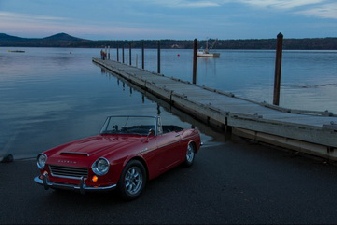
Updated: 03-


Hydraulic Systems
Your brakes and clutch are operated by hydraulic systems which utilise brake fluid working with seals, cylinders and pistons. The brake fluid deteriorates and absorbs moisture after time. This moisture can rust the steel parts of your hydraulic system and introduce other impurities which destroy the seals.
Master cylinders are expensive but they can last a long time with proper care. When the fluid is contaminated, it is only a matter of time before the calipers, wheel cylinders, and slave cylinder are affected by bad fluid and the price of replacing these items can also be expensive (see some prices below!).
Climate dictates the rate at which your brake fluid absorbs moisture. The life expectancy of seals and metal parts depends on regular maintenance which should always include a hydraulic flush, yet most manuals do not mention this service.
We recommend flushing the brake and clutch systems once a year because the rate of deterioration of seals, pistons, and cylinder walls increases with the amount of moisture present.
One sign of bad brake fluid is discoloration. Brake fluid goes brown after moisture contaminates it; it goes black after the seals in the master cylinder break down. The last two cars that we serviced had cloudy milky residue and it looked like bacteria growing in the reservoirs.
If your fluid is black, white or badly discolored brown, you should replace all your seals before refilling with new fluid. While dismantling the seals you will examine all the cylinders and pistons and will know whether you need to replace any or all of them. Any corrosion on a surface against which a seal moves usually necessitates replacement.
Which Type of Fluid?
A litre of good brake fluid a year (DOT 3 minimum, DOT 4 is better because its rate of water absorbtion is slower than DOT3, and it can withstand higher temperatures) will save many systems and save you money in the long run. Cars that are daily drivers can spread the maintenance interval over 18 months as long as the fluid is clear.
We do not recommend DOT5 silicone brake fluid. However, it does have some advantages: unlike DOT3 or DOT4, DOT5 does not ruin paint or absorb water. Unfortunately any water that does get into the hydraulic system tends to pool into one spot where it can corrode metal badly; in addition, it is difficult to get a hard brake pedal and it is expensive. If you feel that its advantages outweigh its disadvantages, make sure that you replace every part of the brake system because DOT5 does not mix with the other two.
What Tools are Needed to Flush and Bleed the System?
A flare wrench: this is similar to a ring wrench but it has a gap in the ring just sufficient to allow the brake tubing to go through.
A clear tube which fits the bleed nipples.
A transparent container sufficient for about one liter of brake fluid. For stability it is preferable to have its diameter at least as large as its height.
How to Flush the System
It is best to have the car on four secure jack stands, with the wheels off, and to have an assistant who keeps the master cylinder reservoir filled and who depresses and releases the brake (or clutch) pedal when asked. You must observe perfect cleanliness and freedom from oil while dealing with hydraulic systems. You and the assistant must have good communication.
Wipe out the crud and refill the reservoir with clean brake fluid; this prevents some of the contaminated fluid going through the rest of the system.
You now replace the rest of the dirty fluid, that is, the fluid in the parts of the system between the brake (or clutch) master cylinder and each wheel cylinder or caliper (or the clutch slave cylinder). If you are dealing with the brakes, you always start with the wheel cylinder or caliper furthest from the master cylinder, and repeat the process with the next furthest, and so on. The wheel furthest from the master cylinder on a typical North American (left hand drive) Roadster is the right rear wheel; the next is the other rear wheel; the next is the right front wheel.
For each wheel cylinder, caliper or clutch slave cylinder:
Clean around the bleed nipple until immaculate.
Check that you can crack the nipple open about one turn with the flare wrench. If you have to use heat, you must replace all seals in the associated cylinder or caliper.
Fit the hose snugly over the nipple, with the other end of the hose in the container. Bleeding Procedure:
Push the pedal down once and leave it down. (Dirty fluid flows into the container.) Note that if you don't leave the pedal down until you tighten the nipple, dirty fluid flows back into the system
Tighten the nipple.
Release the pedal.
Check and top up the fluid level in the master cylinder (usually only needed every
dozen or so cycles of this sequence -
Slacken the nipple.
Repeat this sequence until the fluid flow is clean and without bubbles.
Tighten the nipple.
Buying parts:
When ordering any hydraulic part it is important to know what size, (7/8, 3/4, 13/16, 5/8), what make (Nabco, Tokiko) you are rebuilding or replacing.
For the 1500 wheel cylinders, four different types are used on the front alone, so state which ones your car has.
We recommend replacing hydraulic units over rebuilding with new seals -
You will find that buying brake parts can add up in a hurry. Yet, one hour a year flushing hydraulic systems can save you lots of expensive repairs!